34 Flowering Shrubs That Bloom All Summer (With Pictures)

Flowering shrubs that bloom throughout summer are a fantastic addition to any garden. These shrubs provide continuous color from late spring through fall. Their beauty throughout the summertime transforms your garden into a vibrant, colorful, inviting space.
Some of the best shrubs that flower all summer long include reblooming hydrangeas, azaleas, roses, butterfly bushes, and long-blooming mountain laurels. These flowering shrubs produce a steady stream of blossoms throughout the summertime.
If you want to create a garden bursting with blooms all summer, this article is for you. You will find a list of the best flowering shrubs to fill your yard with perpetual flowers throughout the summer. Descriptions and pictures of long-blooming shrubs will help you decide how to landscape your front or backyard.
Additionally, you will find helpful tips on how to care for these shrubs to ensure you have a never-ending floral display in your garden.
What are Flowering Shrubs That Bloom All Summer?
Many bushy plants are flowering perennial shrubs with a long blooming season. The summer spectacle of non-fading blooms can start early in spring and persist until frost. Some summer-flowering shrubs rebloom sporadically through the warmer months. Even in temperate climates, you can find many shrubs with flowers that last the entire summer.
Flowering Shrubs That Bloom Throughout Summer (With Pictures): Identification Guide
Please read on to find a variety of flowering shrubs with extended flowering periods. Descriptions and pictures of these shrubs will help you choose the best plants to keep your garden landscape alive with color all summer.
Rose of Sharon (Hibiscus syriacus)
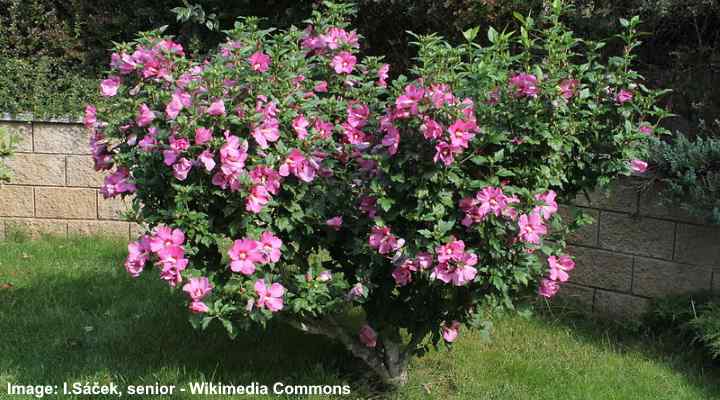
Rose of Sharon is a deciduous flowering shrub that produces large, showy flowers all summer. The attractive trumpet-shaped flowers bloom in white, pink, lavender, red, and multicolored shades. Blooming continuously from early summer through fall, the hardy ornamental hibiscus shrub has a bushy, vase shape and lobed leaves.
Thriving in full sun to partial shade, flowering Rose of Sharon shrubs grow 8 to 10 ft. (2.4 – 3 m) tall and wide. The non-stop flowering shrubs are low-maintenance, drought-tolerant, and can withstand heat and humidity. Rose of Sharon hibiscus shrubs are ideal for borders, screens, hedges, and specimen planting. Their fragrant, exotic flowers attract butterflies and hummingbirds with their nectar-rich blooms.
USDA Zone: 5 to 9
Sun Exposure: Full sun to partial shade
Soil Type: Well-drained, moist soil
Tropical Hibiscus (Hibiscus rosa-sinensis)

Tropical hibiscus is a stunning flowering tropical shrub that blooms throughout the entire summer, from spring through late fall. Thriving in full sun to part shade, the tropical hibiscus is known for its exotic trumpet-like flowers consisting of papery, ruffled petals and a protruding stamen. The stunning pink, red, yellow, white, and multicolored flowers can measure up to 4” (10 cm).
Also called Chinese hibiscus, the shrub grows 6 to 8 ft. (1.8 – 2.4 m) tall. The attractive, fast-growing shrubs and showy flowers add a touch of exotic beauty to any garden or landscape. Some dwarf shrub varieties can be as short as 2 ft. (0.6 m) tall; however, the largest tropical hibiscus shrubs can grow around 15 ft. (4.5 m) tall.
Tropical hibiscus shrubs require regular watering during hot, dry periods to keep them blooming all summer long. The exotic shrubs are popular for tropical gardens, foundation planting, containers, and as a focal point in landscape design. Their evergreen foliage means hibiscus shrubs are also excellent privacy screens.
USDA Zone: 10 to 12
Sun Exposure: Full sun or partial shade
Soil Type: Well-drained, loamy soil that is slightly acidic
Butterfly Bush (Buddleja spp.)

Butterfly bush is a flowering perennial shrub with continuous blooms throughout the summertime. Requiring full sun, the ornamental shrub is known for its long spikes of fragrant flowers in various purple, pink, white, and yellow shades. The flowers attract masses of butterflies—hence the name butterfly bush. The long-blooming shrubs can grow up to 5 to 8 feet (1.5 – 2.4 m) tall and wide.
Butterfly bushes bloom from summer to fall without needing deadheading, making them excellent shrubs for front-of-house landscaping. The spiky, conical flowerheads on long stems make a dramatic statement as a focal point in landscapes. You can also grow the flowering shrubs in butterfly gardens, urban landscapes, as an informal hedge. Their tolerance to drought makes them excellent for xeriscape landscapes.
USDA Zone: 5 to 9
Sun Exposure: Full sun
Soil Type: Well-drained soils with medium moisture
Crape Myrtle (Lagerstroemia indica)
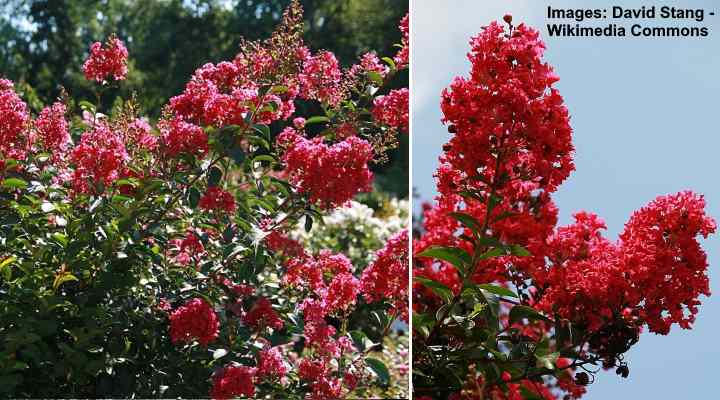
Crape myrtle is a beautiful flowering shrub that blooms reliably from early summer through fall. The long-lasting blooms are showy clusters of crepe paper-like flowers in pink, red, white and purple shades. The flowers contrast nicely with the glossy, leathery leaves that turn golden yellow, orange, and red in the fall.
Crape myrtle shrubs thrive in full sun and are covered in masses of flowers throughout summer and into fall. The tree-like fast-growing shrubs grow 6 to 30 ft. (1.8 – 9 m) tall. The multi-stemmed shrub has attractive peeling bark, showy flowers, and glossy green leaves, giving it an all-season appeal.
Resistant to drought and hot summers, a crape myrtle shrub is ideal as a focal point in gardens. You can also plant them as a flowering hedge or privacy screen or train them to grow as an ornamental tree.
USDA Zone: 7 to 9
Sun Exposure: Full sun
Soil Type: Most soil types that are moist and well-draining
Smooth Hydrangeas (Hydrangea arborescens)

Blooming from early summer to fall, smooth hydrangeas are deciduous shrubs with large, showy flower heads. Identifying features of smooth hydrangeas are rounded, creamy-white flower clusters, egg-shaped, sharply toothed leaves, and buttery-yellow fall colors. Thriving in full sun to dappled shade, smooth hydrangeas grow 3 to 6 ft. (1 – 1.8 m) tall and wide.
Smooth hydrangeas are cold-hardy shrubs that fill summer landscapes with huge blooms. Some varieties of hydrangeas have round flower heads that can reach up to 12” (30 cm) in diameter. Smooth hydrangeas are often used to landscape mixed shrub borders, grow as a flowering hedge, or create a backdrop for perennials.
USDA Zone: 3 to 8
Sun Exposure: Full sun to dappled sunlight
Soil Type: Well-drained soil that is consistently moist during hot summers
Panicle Hydrangeas (Hydrangea paniculata)
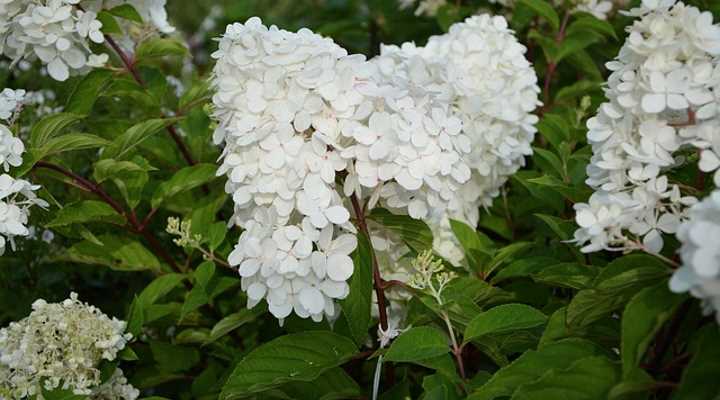
Panicle hydrangeas are large shrubs that start blooming from late to mid-spring and continue flowering into fall. The highly attractive deciduous shrubs are popular for their large, cone-shaped flower clusters. The branches bend under the weight as the huge flowers cover the shrub in summer. The large ornamental shrubs grow 10 to 25 ft. (3 – 7.5 m) tall.
Panicle hydrangeas bloom in shades of pink, pale red, and creamy white. These low-maintenance hydrangeas require minimal pruning to thrive in sunny landscapes. Thanks to their ornamental appeal, they are popular landscaping shrubs for specimen plants, hedges, or foundation planting. You can also plant the long-blooming shrubs along a fence line, a wall, or to accent taller trees.
USDA Zone: 3 to 8
Sun Exposure: Full sun, dappled sunlight, or partial shade
Soil Type: Well-drained, rich soil with medium moisture
Magenta Rock Rose (Cistus pulverulentus)

Magenta rock rose is a stunning small evergreen flowering shrub that blooms tirelessly throughout the entire summer, from late spring until early fall. Thriving in full sun, this shrub blooms with vibrant magenta flowers consisting of papery petals surrounding a dull yellow center. The rich cerise flowers contrast with the small oval fuzzy green leaves.
Magenta rock rose grows 2 to 3 ft. (0.6 – 1 m) tall and spreads up to 8 ft. (2.4 m) wide. This drought-tolerant pink-flowering shrub is drought and salt tolerant, making it ideal for coastal landscapes. The heat-loving shrubs are also popular for growing in gardens, borders, or as a focal point in the landscape.
Its spreading, low-growing habit makes magenta rock rose ideal for pink-flowering ground cover in full sun. Its vibrant flowers attract pollinators like bees and butterflies, adding even more life to your garden.
USDA Zone: 8 to 10
Sun Exposure: Full sun
Soil Type: Well-drained soil
Weigela (Weigela florida)

Weigela is a deciduous shrub that is a reliable summer bloomer, producing beautiful trumpet-shaped flowers. Blooming all summer long from spring until frost, the mounding shrub is covered in pink, red, and white flowers. The densely growing shrub also has narrowly ovate leaves, adding texture and greenery to summer gardens
Weigela flowers bloom in late spring and persist for several months, attracting hummingbirds and butterflies. The shrubs grow 4 to 5 ft (1.2 – 1.5 m) tall and wide. This versatile landscaping shrub is ideal for adding a pop of color to foundation plantings and borders in sunny landscapes.
Weigela plants are easy to grow and require minimal maintenance. Regular pruning after flowering helps maintain a compact shape and promotes more summer blooms the following year.
USDA Zone: 4 to 8
Sun Exposure: Full sun to partial shade
Soil Type: Moist, well-drained soils
Reblooming Azalea (Rhododendron spp.)
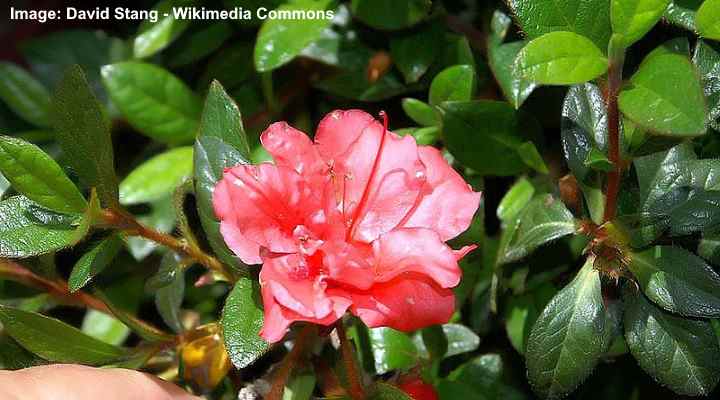
Reblooming azaleas are a type of flowering shrub producing multiple blooms throughout the summertime. With their showy spring flowers, azaleas come early in the season. They then bloom again in midsummer and continue flowering for three months. Typically, reblooming azaleas are dwarf ornamental shrubs that grow around 4 ft. (1.2 m) tall.
Reblooming azaleas are known for their showy pink, red, purple or white flowers and attractive foliage, with glossy green leaves that remain on the shrub year-round.
Continuously blooming azaleas are ideal for adding year-long color to sunny or partially shaded gardens. You can plant the shrubs as a focal point in containers or the ground. Other landscaping uses include mixed borders, mass plantings, or foundation plantings.
USDA Zone: 7 to 9
Sun Exposure: Full sun or partial shade
Soil Type: Moist, well-drained soils
English Lavender (Lavandula angustifolia)

English lavender is a versatile perennial shrubby plant known for its fragrant purple flower spikes lasting all summer. Lavender is prized for its aromatic foliage and flowers. The small purple or blue flowers are trumpet-shaped in cylindrical flower heads up to 3” (7.5 cm) long.
The compact, low-growing mounding plant grows 2 to 3 ft. (0.6 – 0.9 m) tall. It blooms throughout summer and is an excellent addition to herb gardens, borders, rock gardens, and to accent larger shrubs. Lavender is also popular for growing to harvest its aromatic flowers and foliage.
USDA Zone: 5 to 9
Sun Exposure: Full sun or partial shade
Soil Type: Well-drained, partially dry soil
Spanish Lavender (Lavandula stoechas)
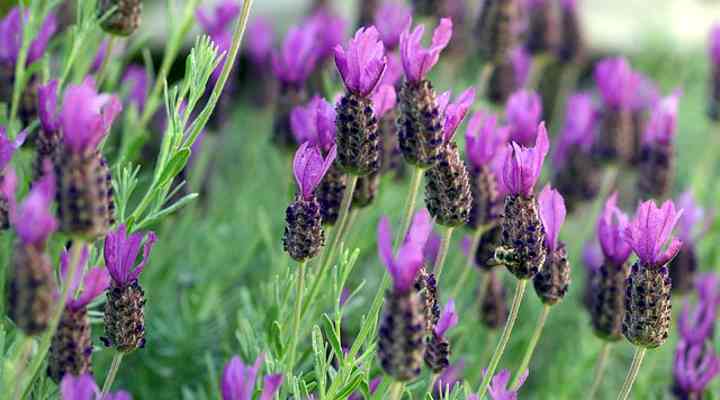
Spanish lavender is a small, beautiful evergreen shrub with pink, purple, or white flowers blooming from mid-spring through late summer. The unique lavender flowers have a tufted appearance with upright petals and a large, colorful bract on top. Thriving in full sun, Spanish lavender grows 2 to 3 ft. (0.6 – 0.9 cm) tall.
The long-lasting, nectar-rich summer flowers attract bees, butterflies, and other pollinators to the garden. Like English lavender, the Spanish variety has aromatic narrow, gray-green leaves. Thriving in full sun, this drought-tolerant purple-flowering shrub is ideal for herb gardens, flower beds, borders, and rock gardens. You can also grow it in containers.
USDA Zone: 6 to 11
Sun Exposure: Full sun
Soil Type: Poor, light, sandy soil with excellent drainage
White Meadowsweet (Spiraea alba)

White meadowsweet is a versatile flowering shrub that continuously produces clusters of beautiful blooms from early summer through late fall. Spirea flowers are conical clusters of delicate five-petaled blooms with prominent stamens. The white or pale pink flowers are highly fragrant and provide continuous color and interest in the garden.
Reaching a height of 3 to 4 ft. (1 – 1.2 m), white meadowsweet is easy to grow and requires minimal maintenance. Blooming for two months from early summer, the attractive flowers are followed by clusters of small seed pods. You can grow the sun-loving shrub along ponds and streams or in cottage gardens.
USDA Zone: 4 to 8
Sun Exposure: Full sun to partial shade
Soil Type: Medium to wet soil
Chaste Tree (Vitex agnus-castus)

Chaste tree is a deciduous shrub producing beautiful spikes of fragrant flowers throughout the summer. The unwavering blooms of this summer-flowering shrub appear in various shades of pink, purple, lilac, and white. Chaste trees typically grow 8 to 20 feet (2.4 – 6 m) tall and wide, with many cultivars of various sizes.
Chaste tree is a low-maintenance shrub for full sun, featuring gray-silver compound leaves. Its conical flower clusters measure 3 inches (7.5 cm) in length, with drupes appearing in the fall. Popular landscaping options for chaste trees include creating a focal point in the garden, growing a flowering hedge, or mass planting for a privacy screen.
USDA Zone: 7 to 9
Sun Exposure: Full sun
Soil Type: Moist soil with good drainage, and it also tolerates occasionally dry soil
Glossy Abelia (Abelia × grandiflora)
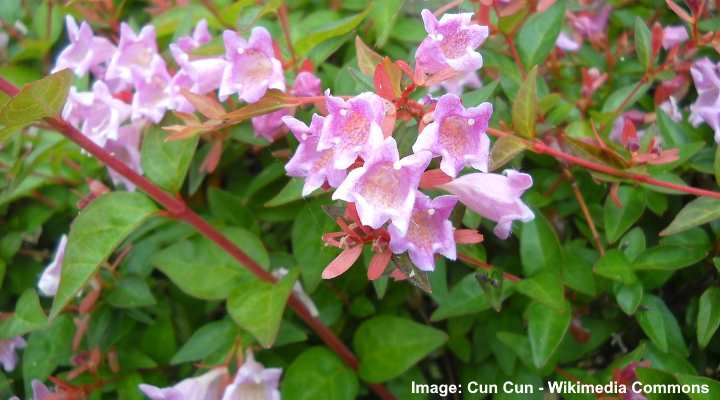
Glossy abelia is a versatile shrub producing clusters of fragrant flowers that withstand hot summer months. The bell-shaped flowers appear in late spring and bloom continuously to early fall. Glossy abelia flowers are highly fragrant and bloom in white, pink, and lavender shades. The summer-flowering shrub grows 3 to 6 ft. (1 – 1.8 m) tall.
An attractive feature of glossy abelia is its glossy, dark green leaves growing on arching branches. Additionally, the deciduous shrub has eye-catching bronze or purple fall colors before the leaves drop.
Glossy abelia is a great choice for borders, foundation planting, or as a standalone specimen in a garden. Its dense foliage and bushy growth make it ideal for planting an informal low-growing hedge. It can tolerate a wide range of soil conditions and is relatively low-maintenance.
USDA Zone: 5 to 9
Sun Exposure: Full sun to partial shade
Soil Type: Well-drained, organically rich, moist soil
Beautybush (Kolkwitzia amabilis)

Beautybush is a deciduous shrub blooming with beautiful light pink flowers in the spring that last until the end of summer. Identifying features of this long-blooming shrub are its upright vase shape, clusters of small pale pink flowers, and dark bluish-green oval leaves. During its bloom time throughout summer, the shrub produces a stunning floral display.
The beautybush shrub grows 6 to 10 ft. (1.8 – 3 meters) tall and wide. The easy-grow shrub has non-fading summer flowers and a spread of 8 to 12 feet (2.4 to 3.7 meters).
In addition to its attractive flowers, beautybush has dark green leaves that turn a vibrant reddish color in the fall. In winter, its attractive reddish-brown peeling bark gives it appeal all year long. This low-maintenance, drought-tolerant plant is useful for growing as a hedge, screen, foundation planting, or shrub border.
USDA Zone: 4 to 8
Sun Exposure: Full sun to partial shade
Soil Type: Well-drained soils with medium moisture
Bloomerang Lilacs (Syringa ‘Bloomerang’)

Bloomerang lilac shrubs put on a spectacular floral display in spring and then bloom repeatedly from mid-summer through fall. Reblooming lilacs have the characteristic lilac flowers consisting of dainty star-shaped flowers in conical clusters. Also, the shrub’s neat, rounded shape and heart-shaped leaves make it attractive throughout the year.
Compact Bloomerang lilac shrubs grow 5 ft. (1.5 m) tall and wide. The arching pyramidal clusters are typically purple, but some varieties have white and pink shades.
Bloomerang lilacs are a great addition to any garden or landscape. The long-blooming shrubs provide beauty, fragrance, and color throughout the growing season. To enjoy a parade of flowers from spring through fall, you can plant reblooming lilacs as specimen plants, in borders, or as a hedge.
USDA Zone: 3 to 7
Sun Exposure: Full sun to partial shade
Soil Type: Moist, well-drained alkaline soil
Shrub Roses (Rosa)
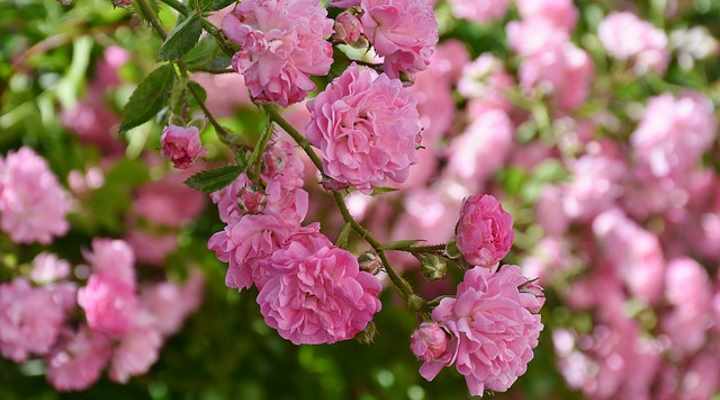
Shrub roses are hardy flowering plants that add beauty and fragrance to any garden for constant flowering throughout the summer. These perennial roses feature blossoms with cup-shaped flowers in red, pink, apricot, red, white, and yellow shades. Shrub roses have a long blooming period and are extremely floriferous in summer.
Growing 4 to 5 ft. (1.2 – 1.5 m) tall, shrub roses are ideal for low-maintenance gardens. The flowering shrubby plants grow well in mixed borders, beds, or in a row as a flowering hedge. You can also grow attractive flowering rose shrubs in containers to decorate a balcony, patio, or deck area.
Regular pruning and deadheading will help promote continuous blooming throughout the season.
USDA Zone: 5 to 10
Sun Exposure: Full sun
Soil Type: Well-drained, humus-rich soil
Hybrid Tea Rose (Rosa heirloom)

Hybrid tea roses are popular plants that grow as bushy shrubs, known for their large and sweet-scented blooms that last throughout the entire summer. Heirloom roses showcase a wide range of colors and flower forms—from single blooms to fancy double flowers with ruffled petals. Hybrid tea roses typically grow as bushy shrubs, reaching heights of 3 to 4 ft. (1 – 1.2 m).its u
Hybrid tea roses constantly bloom throughout the summertime. However, you must water them regularly to enjoy their spectacular showy flowers all summer. Popular landscaping uses for hybrid tea roses are flower beds and borders, foundation plantings, and hedges. Regular pruning and maintenance are necessary to maintain their blooming time throughout the summer.
USDA Zone: 7 to 10
Sun Exposure: Full sun
Soil Type: Fertile, well-drained soil that has adequate moisture
Black Chokeberry (Aronia melanocarpa)
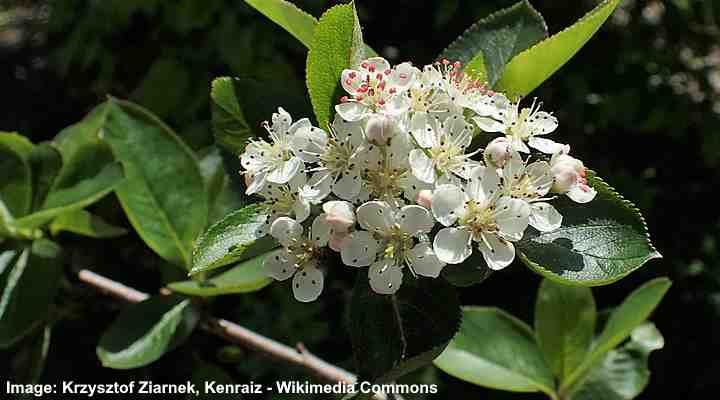
Black chokeberry is a deciduous shrub that produces clusters of small white flowers in the spring that bloom for several weeks through summer. Chokeberry flowers have five petals and pink-topped stamens. These dainty blooms grow in dense clusters. They are followed by dark purple to black berries in the summer.
Black chokeberry plants are known for their attractive dark green foliage, which turns a vibrant red color in the fall. The hardy flowering shrubs tolerate various soil conditions and survive in wet soggy soil. The long-blooming shrubs grow 3 to 6 ft. (1 – 1.8 m) tall and wide.
Black chokeberries have many uses in landscaping for their attractiveness. The dark green leaves, black berries, and white flowers attract wildlife and provide ornamental value. You can plant the shrubs for summer-long blooms in native plant gardens and foundation plantings.
USDA Zone: 3 to 8
Sun Exposure: Full sun to partial shade
Soil Type: Moist, well-drained soil
Mountain Laurel (Kalmia latifolia)
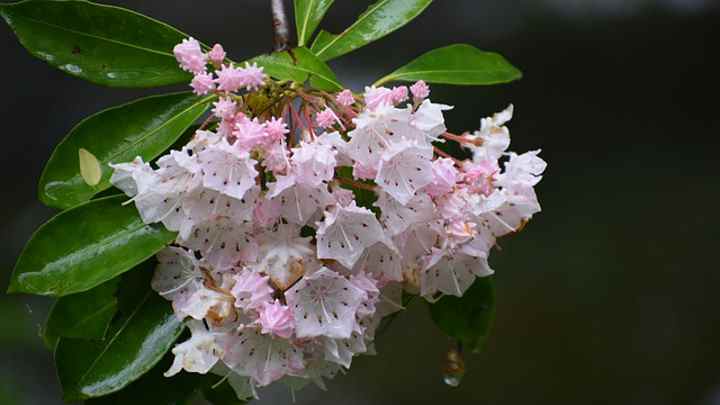
Mountain laurel is a beautiful evergreen shrub with clusters of pink, white, or red flowers appearing in May and blooming until fall. The showy pink and white flowers are bell-shaped spring flowers that contrast nicely with the glossy dark green leathery leaves.
Native to North America, mountain laurel is one of the most attractive ornamental native shrubs for gardens.
Mountain laurel shrubs grow 5 to 15 ft. (1.5 – 4.5 m) tall and wide. The shrubs perform well in shaded areas such as shrub borders, naturalized areas, and cottage gardens. Their unique flowers and glossy foliage make it a standout choice for formal and informal gardens.
USDA Zone: 4 to 9
Sun Exposure: Partial shade to full shade
Soil Type: Humus-rich, acidic, well-drained soil
Shrubby Cinquefoil (Potentilla fruticosa)

Shrubby cinquefoil is a hardy perennial shrub that produces a burst of bright color in summer gardens. Blooming from spring until the first frost, the yellow cup-shaped flowers cover the small ornamental shrub. Its small lance-shaped leaves are glossy green, adding to the shrub’s ornamental value.
Shrubby cinquefoil is a low-maintenance plant that grows 2 to 4 ft. (0.6 – 1.2 m) tall and up to 5 ft. (1.5 m) wide. You can plant the drought-tolerant yellow-flowering shrub as informal hedging or mass planting in borders and beds.
Shrubby cinquefoil is native to North America and attracts pollinators to garden landscapes. It’s tolerant to salt, poor soils, and drought.
USDA Zone: 3 to 7
Sun Exposure: Full sun or partial shade
Soil Type: Evenly moist, well-drained soil
Bottlebrush Buckeye (Aesculus parviflora)
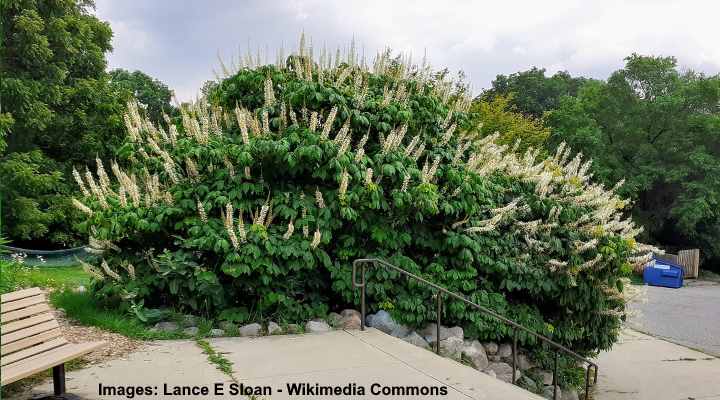
Bottlebrush buckeye is a large deciduous shrub known for its unique bottlebrush-like white flowers. Blooming from early summer for several weeks, the spectacular cylindrical flower clusters cover the ornamental shrub. The shrub’s other attractive features are the lance-shaped leaves growing palmately, yellow fall colors, and pear-shaped fruits.
Ornamental bottlebrush buckeye shrubs grow 8 to 12 ft. (2.4 – 3.6 m) tall and up to 15 ft. (4.5 m) wide. The summer-blooming flowers attract pollinators such as bees and butterflies. Its attractive foliage and bottlebrush-like white flowers make it a great choice for creating a focal point in a garden or landscape.
USDA Zone: 4 to 8
Sun Exposure: Partial shade to full shade
Soil Type: Medium, well-drained soils
Sweet Bay Magnolia (Magnolia virginiana)
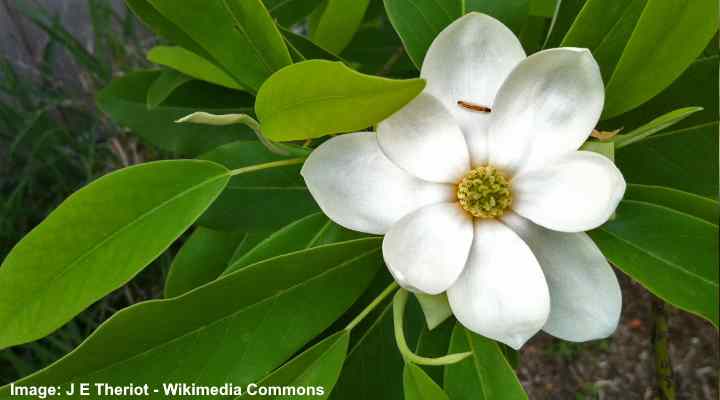
Sweet bay magnolia is prized for its stunning white flowers blooming in spring and sporadically during summer. Ornamental features of sweet magnolia are its fragrant cup-shaped white flowers, leathery green leaves, and showy red cone-like fruit. Also known as laurel magnolia, the white-blooming ornamental shrub grows 10 to 35 ft. (3 – 10 m) tall.
Sweet bay magnolia is native to the southeastern United States. Its beautiful fragrant white flowers add beauty to foundation plantings, shrub borders, or patios when grown in containers. It’s also popular to be grown as a small ornamental tree in sunny landscapes. This magnolia species is also ideal for planting near ponds, streams, or in poorly drained soils.
USDA Zone: 5 to 10
Sun Exposure: Full sun to partial shade
Soil Type: Moist, organically rich soils, including wet, boggy ground
Oleander (Nerium oleander)
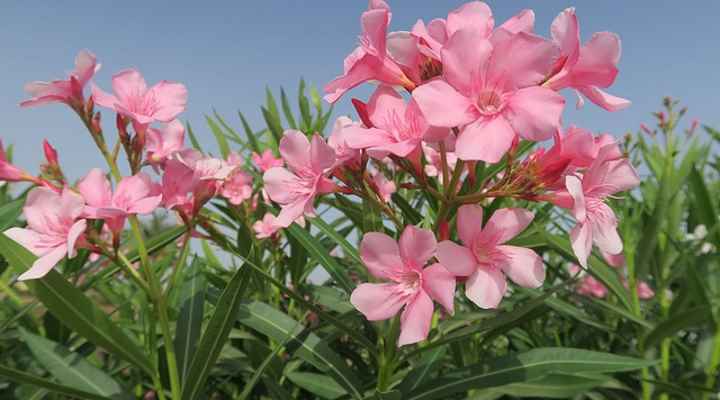
Oleander is a beautiful flowering shrub with showy blooms that appear in early summer and last until early fall. This tough, vigorous shrub thrives in full sun and has year-round blooms in warm climates. The beautiful flowers grow on a bushy shrub with a vase-shaped growth habit and evergreen, lance-shaped leaves. Oleander shrubs grow 6 to 12 ft. (1.8 – 3.6 m) tall.
Oleander is a versatile plant with many landscaping uses in the garden. You can grow this summer-blooming shrub as a flowering hedge, a specimen plant, or in large containers. It’s also tolerant to salt, drought, heat, and wind, making it ideal for planting in seaside gardens or coastal locations.
However, it is important to note that all parts of oleander are toxic if ingested. Therefore, you should be careful when planting it where children or pets commonly play.
Although it thrives in tropical regions, some oleander cultivars are suitable for USDA zones 7 and 8.
USDA Zone: 8 to 11
Sun Exposure: Full sun
Soil Type: Well-drained soil
Texas Lantana (Lantana urticoides)

Texas lantana is a heat-tolerant perennial flower with a long blooming season starting from mid-spring. The shrub is native to Texas and is prized for its tough, heat-tolerant aromatic leaves, rounded clusters of small tubular flowers, and purple-black berries. In winter, after the leaves drop, its light gray, exfoliating bark adds visual interest.
Texas lantana has eye-catching flowers that bloom throughout summer in yellow, pink, and purple shades. The unique blooms attract butterflies, making it a popular choice for wildlife gardens in southern states.
Texas lantana grows 2 to 3 ft. (0.6 – 1 m) tall and has a spreading habit. It’s drought and heat-tolerant and requires little maintenance as a front-of-house-planting. It also adds a pop of color to gardens, coastal landscapes, borders, and containers.
USDA Zone: 8 to 11
Sun Exposure: Full sun
Soil Type: Most soil types if they have good drainage
Trailing Lantana (Lantana montevidensis)

Trailing lantana is a low-growing perennial shrub with flowers that last through the summer from spring until fall. This shrub with trailing stems has beautiful pale purple and white tubular flowers growing in small clusters. The ground-hugging shrub has aromatic evergreen leaves, adding to its landscaping appeal.
Trailing lantana is a purple flowering ground cover plant that spreads 3 to 5 feet (1 – 1.5 m) wide. Its trailing stems, covered in green foliage and lilac flowers, make it an ideal flower for hanging baskets, containers or cascading over a retaining wall.
This spreading lantana shrub is great for adding color and interest to your garden.
It’s good to note that trailing lantana is toxic if ingested and may cause skin irritation when handled.
USDA Zone: 8 to 10
Sun Exposure: Full sun
Soil Type: Medium moisture soils with excellent drainage
California Lilac (Ceanothus)

California Lilac is a fast-growing, heat-hardy shrub with clusters of small, blue fragrant flowers that bloom from mid-spring until winter. The blue-flowering shrub’s ornamental appeal is its cobalt, azure, and indigo fluffy flower clusters. The delightful shrub has ovate leaves with spiny edges.
Native to North America’s west coast, California lilac is a group of versatile shrubs. Taller cultivars are well-suited for growing against walls or covering arbors. Low-growing cultivars have a spreading habit, making them ideal for ground cover in hot climates. The fragrant blue flowers attract hummingbirds, bees, and butterflies.
USDA Zone: 8 to 10
Sun Exposure: Full sun with some afternoon shade in hotter regions
Soil Type: Most types of well-drained soils
Flame of the Woods (Ixora)
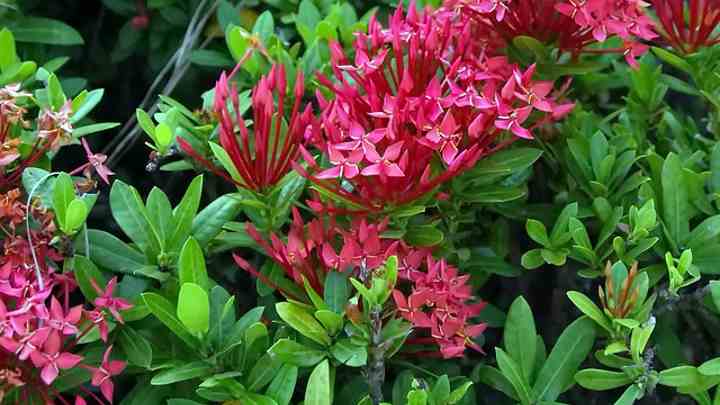
Flame of the woods is a tropical flowering shrub that produces clusters of vibrant, fiery-colored flowers throughout summer. The freely blooming bushy plant has four-petaled red, orange, pink or yellow tubular flowers, leathery, oblong leaves, and purplish-black fruits. The evergreen shrub grows 4 to 6 ft. (1.2 – 1.8 m) tall.
Ixora plants are popular for their showy and long-lasting blooms. They have tremendous ornamental appeal in tropical gardens as hedges, foundation plantings, or creating a dense privacy screen.
USDA Zone: 9 to 11
Sun Exposure: Full sun
Soil Type: Well-drained soil
Bougainvillea

Bougainvillea is a stunning shrubby vining plant with vibrant blooms that last the entire summer. This tropical shrub has woody vine stems that can grow as a shrub or be trained to climb walls, fences, and trellises. The colorful flower-like bracts can be in deep purple, vibrant red, pink, orange or white shades.
Bougainvillea is a sun-loving plant that grows 15 to 40 ft. (4.5 – 12 m) tall and wide in warm climates. Landscaping uses for bougainvillea include privacy screens, flowering hedges, or covering an arbor, pergola, or walls.
Due to the shrub’s sharp spines, bougainvillea is a popular choice for securing screening.
USDA Zone: 9 to 11
Sun Exposure: Full sun, at least six hours of sunlight daily
Soil Type: Well-drained soil but withstands dry, arid conditions
‘Scentsation’ Honeysuckle (Lonicera periclymenum ‘Scentsation’)

Scentsation’ honeysuckle is a fragrant shrubby vine known for its sweet-smelling summer flowers that add a yellow hue to gardens from mid-spring to late summer. This yellow-flowering plant blooms throughout the summer and features flowers with spidery petals among deep green leaves.
‘Scentsation’ honeysuckle vines can grow up to 8 to 10 feet (2.4 – 3 m) tall and up to 6 ft. (1.8 m) wide. It’s an excellent landscaping plant for climbing over a trellis, arbor, pergola, or fence.
USDA Zone: 4 to 9
Sun Exposure: Full sun to partial shade
Soil Type: Most well-drained soils
Major wheeler Honeysuckle (Lonicera sempervirens ‘Major Wheeler’)

The red flowering honeysuckle ‘Major Wheeler’ is a shrubby vine and one of the longest blooming honeysuckle varieties. It blooms non-stop from late spring through the summer and into autumn with attractive crimson flowers that attract butterflies and hummingbirds to the garden.
Adding to its appeal, the stems of the ‘Major Wheeler’ honeysuckle start as reddish-maroon and turn to green-brown when mature. It is a fast growing deciduous vine that can reach 6 to 10 ft. (1.8 – 3 m) tall, and can be used to cover ugly fences, arbors or trellises. The vining shrub is also drought tolerant once established.
USDA Zone: 4 to 8
Sun Exposure: Full sun to partial shade
Soil Type: Well-drained soils
St John’s Wort (Hypericum spp.)
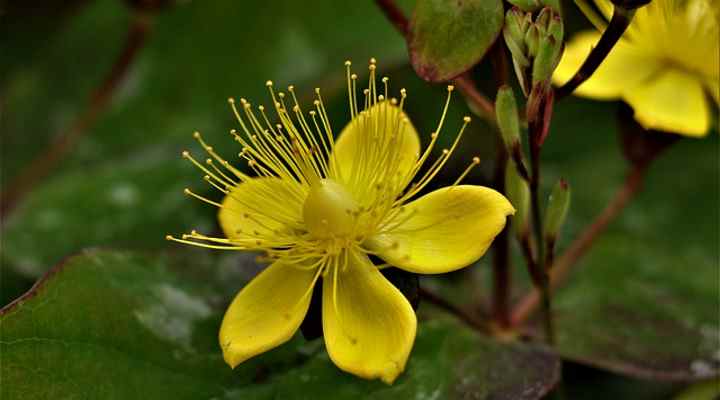
St John’s wort is a versatile shrub that produces bright yellow flowers from early to late summer. The five-petaled flowers bloom in clusters and have showy stamens, and blue-green, slender, lance-shaped leaves that add to its ornamental value. St John’s wort grows up to 3 ft. (1 m) tall.
St John’s wort is low-maintenance and tolerant of a wide range of growing conditions. The drought-tolerant, cold-hardy shrub is ideal for brightening borders, flower beds, and container gardens throughout the entire summer.
USDA Zone: 3 to 8
Sun Exposure: Full sun to partial shade
Soil Type: Moist, well-drained soils
Buttonbush (Cephalanthus occidentalis)

Buttonbush is a deciduous shrub that produces unique globular clusters of white flowers from late spring through August. The attractive flower clusters resemble buttons, hence the name “button bush.” The shrubs also have attractive dark green, glossy leaves creating dense foliage.
Buttonbush shrubs grow 5 to 8 ft. (1.5 – 2.4 m) tall and have a rounded growth habit. The flowering shrubs have a long-blooming season from June to August and prefer moist or wet soil. Therefore, they are excellent landscaping choices to accent ponds or streams or grow in soil with poor drainage.
USDA Zone: 5 to 9
Sun Exposure: Full sun to partial shade
Soil Type: Moist to wet soil
Salt Cedar (Tamarix ramosissima)

Salt cedar is an attractive thicket-forming shrub with decorative pink flowers and feathery foliage. The shrub’s long blooming time lasts from late spring through early fall. Ornamental features of the shrub include juniper-like leaves, arching branches, delicate pink flowers, and dry, flattened seed pods.
Salt cedar grows 10 to 15 ft. (3 – 4.5 m) tall and has a spreading, arching growth habit. Its small, pink flowers attract bees and butterflies, making salt cedar a great addition to pollinator gardens. Its foliage is also aesthetically pleasing, with bluish-green needle-like leaves.
Salt cedar is a hardy plant that can tolerate a wide range of soil conditions, including those with high salt content. It is also drought-tolerant and can thrive in areas with low water availability. Landscaping uses for salt cedar shrubs include windbreaks, informal hedges, and erosion control.
USDA Zone: 3 to 8
Sun Exposure: Full sun
Soil Type: Well-drained soil, tolerant of high salt content
Related articles:
